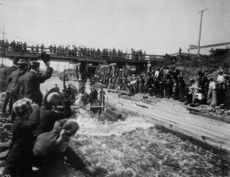
Timber slide
Encyclopedia

Timber
Timber may refer to:* Timber, a term common in the United Kingdom and Australia for wood materials * Timber, Oregon, an unincorporated community in the U.S...
past rapids and waterfall
Waterfall
A waterfall is a place where flowing water rapidly drops in elevation as it flows over a steep region or a cliff.-Formation:Waterfalls are commonly formed when a river is young. At these times the channel is often narrow and deep. When the river courses over resistant bedrock, erosion happens...
s. Their use in Canada
Canada
Canada is a North American country consisting of ten provinces and three territories. Located in the northern part of the continent, it extends from the Atlantic Ocean in the east to the Pacific Ocean in the west, and northward into the Arctic Ocean...
was widespread in the 18th and 19th century timber trade. At this time, cut timber would be floated down river
River
A river is a natural watercourse, usually freshwater, flowing towards an ocean, a lake, a sea, or another river. In a few cases, a river simply flows into the ground or dries up completely before reaching another body of water. Small rivers may also be called by several other names, including...
s in large timber rafts from logging camps to ports such as Montreal
Montreal
Montreal is a city in Canada. It is the largest city in the province of Quebec, the second-largest city in Canada and the seventh largest in North America...
and Saint John, New Brunswick
Saint John, New Brunswick
City of Saint John , or commonly Saint John, is the largest city in the province of New Brunswick, and the first incorporated city in Canada. The city is situated along the north shore of the Bay of Fundy at the mouth of the Saint John River. In 2006 the city proper had a population of 74,043...
. Rapids and waterfalls would, however, damage the wood and could potentially cause log jams. Thus at these locations timber slides were constructed. These were thin water filled chutes that would run parallel
Parallel (geometry)
Parallelism is a term in geometry and in everyday life that refers to a property in Euclidean space of two or more lines or planes, or a combination of these. The assumed existence and properties of parallel lines are the basis of Euclid's parallel postulate. Two lines in a plane that do not...
to the river. They would usually only be wide enough for a single log and one at a time the logs would be directed down it. The idea is attributed to Ruggles Wright
Ruggles Wright
Ruggles Wright was a Canadian lumber merchant, the youngest son of Philemon Wright.He was born in Woburn, Massachusetts but moved to Canada with his parents while still young. He later joined the family business in the timber trade. In 1829, he built the first timber slide on the Ottawa River to...
who introduced the first one in 1829 not far from what is today down-town Hull, Quebec
Hull, Quebec
Hull is the central and oldest part of the city of Gatineau, Quebec, Canada. It is located on the west bank of the Gatineau River and the north shore of the Ottawa River, directly opposite Ottawa. As part of the Canadian National Capital Region, it contains offices for twenty thousand...
, Canada http://www.collectionscanada.ca/canadiandirectories/022009-1100-e.html. Later the slides could often be up to a kilometre in length. They were most commonly found on the Ottawa River
Ottawa River
The Ottawa River is a river in the Canadian provinces of Ontario and Quebec. For most of its length, it now defines the border between these two provinces.-Geography:...
system.
In some areas the timber slide became a noted tourist attraction. The most notable being the one bypassing the Chaudière Falls
Chaudière Falls
The Chaudière Falls are a set of cascades and waterfall in the centre of the Ottawa-Gatineau metropolitan area in Canada where the Ottawa River narrows between a rocky escarpment on both sides of the river. The location is just west of the Chaudière Bridge, northwest of the Canadian War Museum at...
on the Ottawa River in Ottawa. Even the Prince of Wales
Prince of Wales
Prince of Wales is a title traditionally granted to the heir apparent to the reigning monarch of the United Kingdom of Great Britain and Northern Ireland and the 15 other independent Commonwealth realms...
, who later became King Edward VII
Edward VII of the United Kingdom
Edward VII was King of the United Kingdom and the British Dominions and Emperor of India from 22 January 1901 until his death in 1910...
took a thrilling ride down the 1.2 km chute (see photo).
Timber slides disappeared after the construction of canal networks and the decline of the timber trade. They were almost all out of service by the First World War
World War I
World War I , which was predominantly called the World War or the Great War from its occurrence until 1939, and the First World War or World War I thereafter, was a major war centred in Europe that began on 28 July 1914 and lasted until 11 November 1918...
.
Resources
- Lee, David. "Lumber Kings and Shantymen: Logging, Lumber and Timber in the Ottawa Valley." Ottawa: Canada, 2006.

